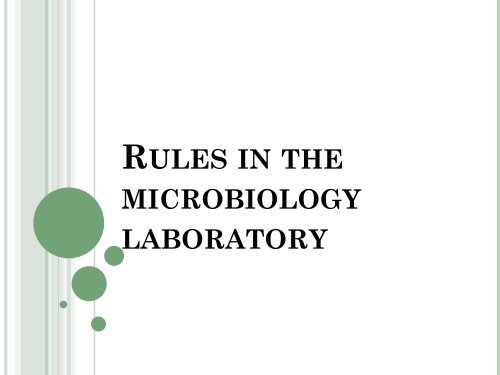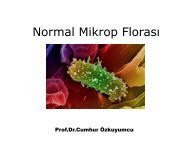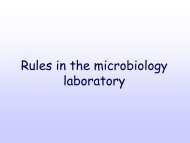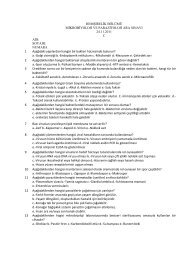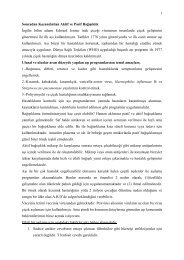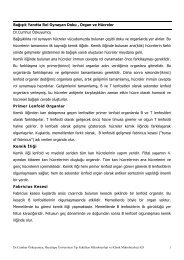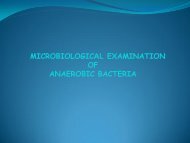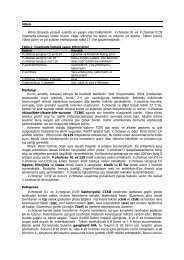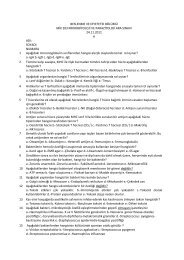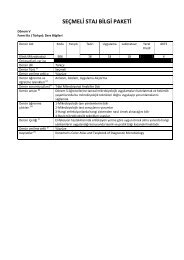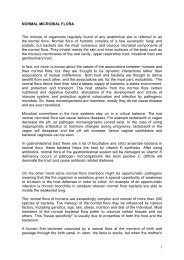Normal Microbial Flora
Normal Microbial Flora
Normal Microbial Flora
You also want an ePaper? Increase the reach of your titles
YUMPU automatically turns print PDFs into web optimized ePapers that Google loves.
RULES IN THEMICROBIOLOGYLABORATORY
RULES Students who are late for the first hour will notbe accepted for the rest of the laboratory. A clean and proper laboratory coat should beworn. Eating or drinking is not permitted in thelaboratory Personal belongings should not be placedon the benches. Long hair should be tied back in order to preventcontact with flames and infectious materials.
RULES Loops and the other metal stuff should be sterilizedbefore and after use. Liquid media should be kept in tube-holders. If the working area is contaminated it should becleaned with alcohol. Benches, microscopes and other labware used shouldbe cleaned up. Hands should be washed with soap before leaving thelaboratory.
NORMALMICROBIALFLORA
<strong>Normal</strong> flora ofthe body mainlyinhabits; Skin Oral cavity Upper respiratorytract Intestinal tract Genitourinary tract
<strong>Normal</strong> flora is beneficial to the bodySome members of normal flora couldbe opportunistic pathogens
Resident <strong>Flora</strong>Microorganisms which are regularlyfound in specific sites of body
Transient <strong>Flora</strong> Microorganisms that inhabit the mucousmembranes for short periods of time Derived from environment Non-pathogenic or potentially pathogenic
Origin of <strong>Normal</strong> <strong>Flora</strong>Acquired during birthAcquired from environment
Anatomical LocationSkinConjunctivaPredominant bacteriastaphylococci and corynebacteriasparse, Gram-positive cocci and GramnegativerodsOral cavityteethmucous membranesstreptococci, lactobacillistreptococci and lactic acid bacteriaUpper respiratory tractnares (nasal membranes)pharynx (throat)Lower respiratory tractstaphylococci and corynebacteriastreptococci, neisseria, Gram-negativerods and coccinoneGastrointestinal tractstomach Helicobacter pylori (up to 50%)small intestinecolonlactics, enterics, enterococci,bifidobacteriabacteroides, lactics, enterics,enterococci, clostridia, methanogensUrogenital tractanterior urethravaginasparse, staphylococci, corynebacteria,entericslactic acid bacteria during child-bearingyears; otherwise mixed
Skin Protective Factors:• Dryness• Low pH• Inhibitory substances Staphylococcus epidermidis(90%) Diphteroids
Mouth Mechanical protection bysaliva Aerobes, facultativeanaerobes, obligateanaerobes Streptococcus mutans
Upper RespiratoryTract Protection by:• Ciliated epithelium• Lysozyme in nasal mucus Nose• Staphylococci Nasopharynx• Streptococci• Neisseria• Haemophilus
Lower RespiratoryTractTrachea andbronchi do nothave a normalflora
GastrointestinalTract Stomach, duodenum Jejunum: Enterococci, lactobacilli,diphteroids Ileum: Anaerobic bacteria,Enterobacteriaceae Colon: Anaerobic bacteria
GenitourinaryTract No microorganismsin kidney, ureterand urinary bladder Lower portion ofurethra• Streptococci,diphteroids Vagina• Lactobacilli (low pH)
ON EVERY BENCHStoolsuspensionEMBagarThroatBloodagarNoseBloodagarSkinBloodagar
STREAK PLATE METHOD
On The Front Bench• Nutrient Broth• Nutrient Agar• EMB Agar• Blood Agar• Chocolate Agar
In June 11, you have a quiz about‘normal flora and serological tests’ at theend of serological tests laboratorytraining.


